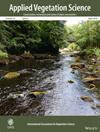Early Competition From a Local Species Seed Mixture Limits Invasion by the Ornamental Shrub Buddleja davidii
Abstract
Questions
One strategy to prevent invasive alien plant species from establishing during the restoration process is to early re-introduce native communities. But can seeding a native herbaceous species mixture of local seeds reduce the establishment of an invasive shrub such as Buddleja davidii? Specifically, we asked: (1) Does competition by native species reduce B. davidii performance? (2) Is this competitive effect on B. davidii more important under higher seed densities? (3) Can it be partly attributed to light competition? (4) How do priority effects moderate this competitive effect?
Location
Disturbed embankment, Isère, France.
Methods
We conducted experiments in controlled conditions, in mesocosms and in the field. We compared the performance of B. davidii when seeded alone or in competition with local seeds, at different densities, when shaded or not and when sown before or simultaneously with respect to native species.
Results
The seeding of a local seed mixture decreased the height, biomass and early-stage survival of Buddleja davidii. Whatever the density, these results were consistent across all three experiments. Buddleja davidii's survival rate was reduced only under the experimental conditions of high shading. When native species were sown after B. davidii, their competitive effect was very low.
Conclusions
Buddleja davidii appears to be sensitive to competition during the early stages of its invasion, especially when local seedlings benefit from a time advantage, regardless of their density. In restoration contexts, native species can prevent the invasion of B. davidii if sowing is carried out as soon as possible.


 求助内容:
求助内容: 应助结果提醒方式:
应助结果提醒方式:


